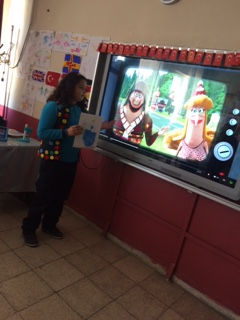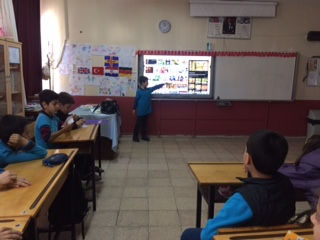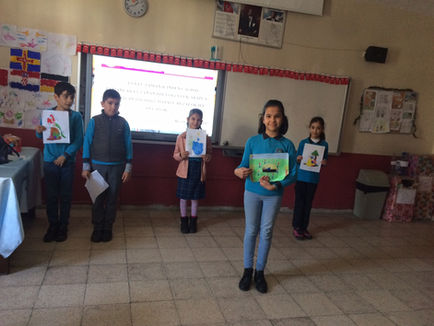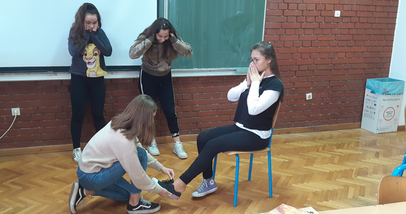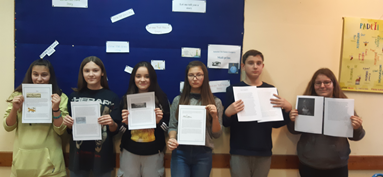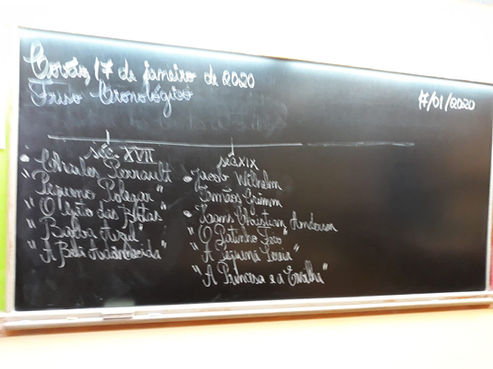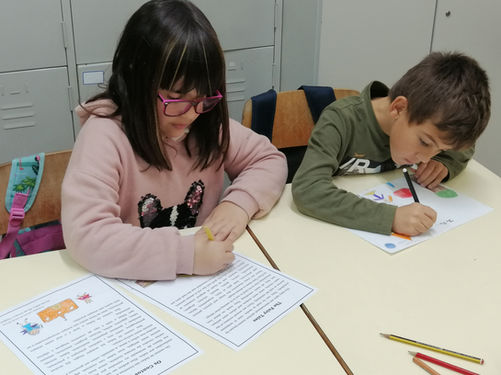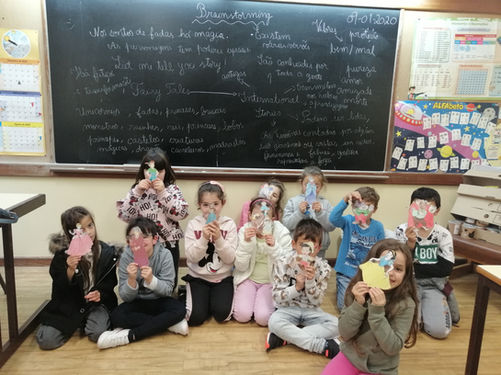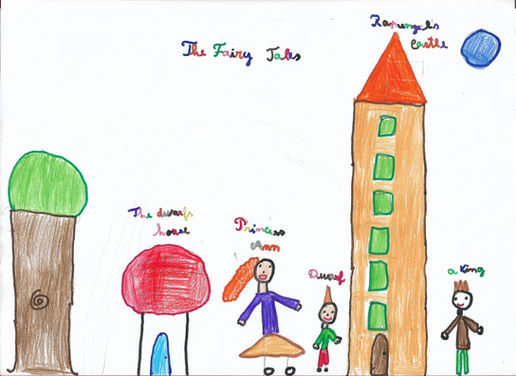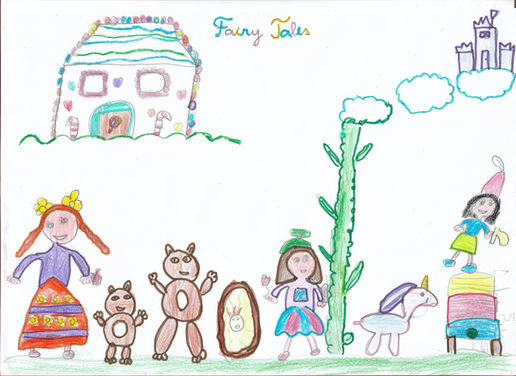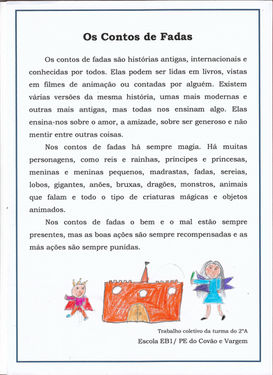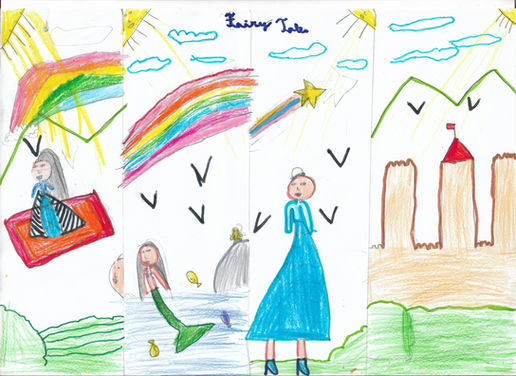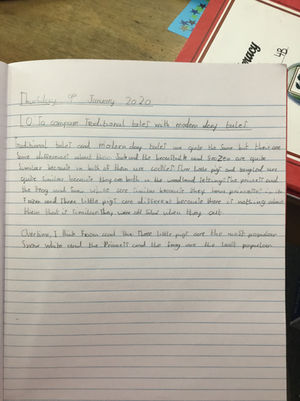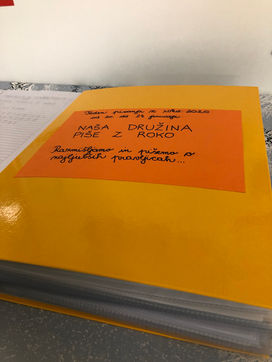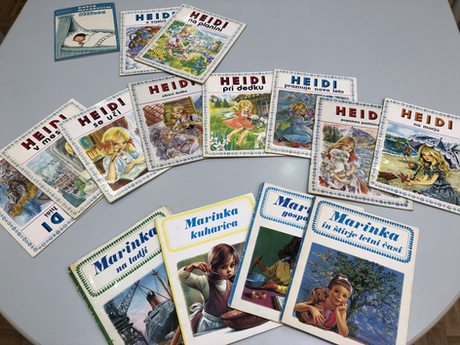Fairy tales from past to now
Turkey
Class 1-B
We have researched and told fables from past to present...
Class 4-B
Croatia
Traditional Little Red Riding Hood and Modern Versions
2nd grade teacher Mateja Pernar and religion teacher Dolores Brkljačić
We have chosen three fairy tales:
-
Little Red Riding Hood (brothers Grimm)
-
Who´s Bad and Who´s Good, Little Red Riding Hood? (Smallman, Price)
-
Little Green Riding Hood (Silvija Šesto).
The students and the teacher read one fairy tale each day of the project week and talked about the characters. Students explained the differences between these fairy tales and talked about their expectations. They also talked about the main problem in the story and how this problem affected the end of the fairy tale.
On the fourth day, students in groups explored the themes and meanings of a fairy tale. After reading the fairy tale, the students made a personal identification card of the main character. Then they had to recognize the relatives, positive and negative characters and find the cause of the problem. With the help of information gathered while solving these tasks, students created a class poster for a particular fairy tale.
On the fifth day the students stayed in the same groups. Each group had a different task.
The first group had to perform an improvised dramatization of its fairy tale with the use of dolls.
The second group had to retell the other students their fairy tale with the help of a story timeline. Students drew specific concepts or ideas on the timeline and those ideas were an association to the fairy tale event.
The third group interpreted its fairy tale with the use of a story dice. The student threw the dice and had to complete the task. There were several tasks on the dice:
-
Retell the story from the point of view of a chosen character (a first-person narrative)
-
Include yourself in the story
-
Invent a funny event in the story
-
Include a new character in the story
-
Change the end of a fairy tale
-
Change the place of the plot
Fairy Tales From the Past with a Modern Twist
Sara Futač and 6th E form students
In Croatian class while working on Croatian Tales of Long Ago, by Ivana Brlić Mažuranić, the students used the storyteller paper tool
(which they made at home) to present six fairy tales: How Quest Sought the Truth, Fisherman Plunk and His Wife, Bridesman Sun and
Bride Bridekins, Little Brother Primrose and Sister Lavender, Yagor and Toporko and His Nine Brothers. On the top side of the storyteller
tool, they drew four drawings associated with a fairy tale. Inside of it, they set eight questions. There was an answer below each question.
Children were divided into groups of 4 – 5 students. Each student in the group had a different fairy tale and a storyteller tool tied to it.
They played with each other using the storyteller tools, asking each other questions, answering them and commenting on which part of fairy
tales they particularly liked. They especially commented on the end of every fairy tale and chose the best one.
After that, they creatively retold the fairy tales by changing the ending. They made it contemporary placing it in the present time and
at today's locations.
Classic and Modern Fairy Tale
Croatian language teacher Marcela Kučeković and the 8th grade students
The main goal of teaching was to find the differences and similarities between modern and classical fairy tales. They were given the task to read the modern fairy tale The Little Prince by Antoine de Saint-Exupery. They had to emphasize the problems that this fairy tale offers, find a classic fairy tale with the same problem and then read it.
In class pupils were divided into groups according to which classic fairy tale they have read. They were given the task to write the similarities and differences between The Little Prince and their chosen classical fairy tale.
After discussing the similarities and the differences they found reading The Little Prince and the classical fairy tale, the students were given the task to classify the characteristics of the fairy tales according to whether they belonged to a classical or a modern fairy tale.
When the results were compared, the students were given the task to act out one of the problems that The Little Prince fairy tale had and rehearse the performance.
After the role-playing game was finished and the students commented each performance, the following task was to design a frozen image of the classical fairy tale. The characters of the classical fairy tale had to speak about themselves after defrosting.
When the students spoke out as if they were one of the characters of the classic fairy tale, they were ready to write their own fairy tales.
The results were quite interesting, unpredictable, imaginative and mythical. Students created fairy tales with different titles: Snowman, Black-haired Woman, The Theft of Gifts, The King and the Servant, The Kingdom of War, Where the Witch Goes, so Goes the Fairy too, The Return of the Witch, I Stay or I Go Back...
World of fairy tales?! NO, it's the world I live in!
(Croatian teacher Vesna Čondić and 6th A form, 6th B form students)
In English class, students read the fairy tales The Happy Prince, The Nightingale and the Rose, The Selfish Giant, The Young King, The Devoted Friend, by Oscar Wilde.
In order to perceive and identify the issues that these fantastic works show, from various activities students learned about their timelessness: the world of fairytales is the world in which they live; fairy tale characters: their good and bad deeds are recognized in the works of the people who live today, people who do not recognize the true human values (think only of the satisfaction of their own interests and needs), but also people who think of the common good, who are ready to sacrifice themselves for the good of the community and its future.
1st Activity
QUIZ TIME: Do I know fairy tales?
In each class, two students were assigned in advance to draw up questions to check the reading, understanding and recognition of the fairy tales of Oscar Wilde, but also the similarity of the motives that were observed in these fairy tales with the motives of previously read fairytales by world famous fairy tale authors, Andersen, the brothers Grimm, Ivana Brlić-Mažuranić (eg. What is the resemblance to the characters of the young king and Cinderella?, Which Wilde's fairy tale reminds you of Andersen's fairy tale, The Little Match girl?). At the beginning randomly drawn and marked with sticky notes captains had to choose three students in their team. It was played in three rounds, for every correct answer the contestant/team was awarded with a point, but also with a candy.
2nd Activity
PRESENTATION of RESEARCH ( GROUP WORK): A fairytale of our choice
Students, according to pre-formed groups, needed to analyze the chosen fairy tale, its theme, plot and characters and then actualize the problems of the modern age that they noticed: the inadequacy and unfairness of society and individuals who care only for their interests, neglect of other people's needs, prices of incorrect life values, etc. They had to express their notions and understandings orally and present it in the form of posters. During the presentation, members of the other groups carefully followed and at the end of the presentation commented on the accuracy, quality and completeness of the posters, as well as the performance of the presentation.
3rd Activity
DRAMATIZATION (GROUP WORK): This is how we experienced it
In the instructions of the given task, the students were supposed to act out the selected part of the fairytale: to write the dialogues themselves, prepare a role play based on the characteristics of the characters, their feelings and the fairy tale's moral. For the top performance they had to practice acting: speech, movement, mimics. Students had to prepare costumes and props, and if possible, they also had to design the scenery.
4th Activity
CREATING a MENTAL MAP (INDIVIDUAL/ PAIR WORK): Fairy tales have taught me...
In the end, the students themselves or in pairs in the form of a mental map, needed to form morals (life values) that they recognized by reading and processing these but also other fairy tales. In the final conversation, the students commented on the curiosities and possible difficulties encountered in the realization of activities, but they also emphasized the satisfaction of recognizing and raising awareness of the problems they witnessed in their environment, and on young generations to make this world a nicer and better place.
Portugal - Madeira
Activity 1
Seizing the opportunity, the students were already participating in a local reading project, we developed the work around the evolution of Fairy Tales. After they presented their stories, the students research for the books and authors and built a timeline. As a result, they organized the information they gathered in a poster.
Activity 2
To introduce the theme of the fairy tales, one of the second-grade classes reflected upon the stories and did a brainstorm of ideas. A game was played where they had to identify the characters and the story it belonged. After that, a collective text was written and illustrated with drawings of their favourites tales.
United Kingdom
We began by discussing what made stories Traditional and then named the ones we knew. Children then chose which Traditional Story was their favourite and wrote about it, including a picture of a scene they like within that story.
We then moved on to reading different Traditional Stories from the past and present, before comparing them and describing how they have changed over time.
Slovenia
Handwriting week
Librarian coordinator Monika Javnornik in collaboration with teachers from central school and its branches.
The students, their parents and grandparents were thinking and writing about their favorite fairy tales. We came to the realization that the grandparents and parents mostly read and listened to fairy tales: Red Riding Hood, Hansel and Gretel, Snow White and the Seven Dwarfs, Cinderella, The Sleeping Beauty. The students also mentioned among these some new age fairy tales.
Exhibition at the library "What we read once". And a comparison of fairy tales once with today's.
At a branch school Mestinje, they read fairy tales in the morning circle and compare what fairy tales used to be and what they are today.
Germany
Class: 6b
School: Erika -Mann- Primary School
Teacher: Ramona Schulz
„Fairytales from the past till now“- „ Let`s play a quiz show “
First we put books, pictures and CDs of fairytales on a table and talked about it, how students get to know to fairytales in our time. Then different groups of three students chose a fairytale they wanted to read together. Each student read some pages aloud and the other two listened . After it they wrote questions about their fairytale with multiple choice answers (A, B or C). One week later the students organized a quiz show with six teams. One student was the quizmaster. He had to ask the questions. After that one member of the group had to run to a letter (A, B or C – stuck on the wall ) which might include the correct answer. For each correct answer the team got a stone made of glass. The group with the most stones won the quizshow.

















